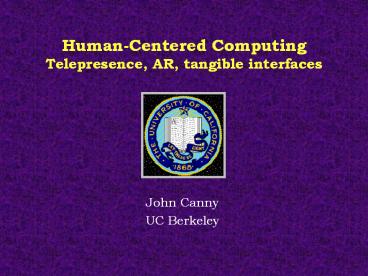Human-Centered Computing Telepresence, AR, tangible interfaces - PowerPoint PPT Presentation
1 / 19
Title:
Human-Centered Computing Telepresence, AR, tangible interfaces
Description:
Nonverbal communication theory (psychology, linguistics, anthropology). Main cues are: ... breakdowns in face-to-face communication, such as gaze aversion. ... – PowerPoint PPT presentation
Number of Views:20
Avg rating:3.0/5.0
Title: Human-Centered Computing Telepresence, AR, tangible interfaces
1
Human-Centered ComputingTelepresence, AR,
tangible interfaces
- John Canny
- UC Berkeley
2
Telepresence, AR, tangible interfacesJohn Canny
- PRoPs (Personal Roving Presences) and gesturing
avatars. - UPM - a universal planar manipulator.
- Bearable computers - turning laptops into
augmented reality systems and wearable computers.
3
PRoPs Personal Roving Presences
Space Browser Eric Paulos
Surface cruiser
4
PRoPs Toward being there
- A PRoP is a Personal Roving Presence.
- PRoPs seek to bridge the gap between telepresence
and being there. - There are two essential aspects of remote
presence that only telerobotics can provide - Non-verbal communication, i.e. gaze, proxemics,
gesture etc. which are highly spatialized. - A gamut of human behaviors, such as chance
encounters, informal meetings, showing or being
shown, browsing, exploring etc, which are
affordances of a physical presence.
5
Terrestrial PRoPs Carts
- Carts are a good match to human capabilities.
- Our strategy was to list important physical
communication skills, and to implement as many as
possible.
6
The rest of the storyA taxonomy of interaction
behaviors
- Verbal symbolic and prosodic
- Nonverbal communication theory (psychology,
linguistics, anthropology). Main cues are - Gaze
- Proxemics
- Facial expression
- Body and hand gesture
- Posture
- Touch
- Example A Handshake depends on all the cues.
7
Differences between verbal and nonverbal
communication
- Adam Kendon (83) summarizes the difference very
well ...gesture has properties different from
speech. In particular, it employs space as well
as time in the creation of expressive forms,
whereas speech can use only time. We find,
therefore, that the way information may be
preserved in speech, as compared to gesture,
tends to be very different.
8
Why nonverbal skills are spatial
- Gaze - very sensitive to mutual direction.
Center-right-left. - Proxemics - Depends on distance to others and the
surroundings. - Facial expression - the least spatial, directed
by gaze. - Gesture - deictic gesture is completely spatial,
so are other pictographic forms. - Posture - Directional.
- Touch - Cant fake it without space.
9
You need social context as well
- Communication.
- Persuasion.
- Trust-building.
- These are radically different contexts that rely
on different non-verbal cues. We need to study
telepresence in representative scenarios.
10
The two-way street
- PRoPs provide selective control over particular
cues. They can be turned on and off at will. - So they provide a potentially interesting testbed
for fine-grained study of non-verbal cues. - We can create a rich variety of media and study
their influence on the overall perception of the
other person.
11
The input side
- How do you achieve rich, expressive input for
PRoPs/avatars with todays technology? - Cross-modal mapping from pen gesture to body
gesture. Both have symbolic and expressive
character
12
Future research?
- Gaze cue repair Face to face is not perfect.
There are common breakdowns in face-to-face
communication, such as gaze aversion. - Beyond Being There It may be possible to rectify
gaze aversion using image processing and/or a
synthetic gaze cue.
13
Project 2UPM A universal planar manipulator
- A smart desk that can move a large number of
objects placed on it independently. - Provides a tangible interface in both directions
for 2D layouts floor plans, landscapes, stage
directions etc. - Uses a small numbers of motors (4) and the
non-linearity of friction.
14
UPM A universal planar manipulator
- First prototype used linear voice-coils from
ancient disk drives, capable of about 2g
acceleration. New prototype should manage about
50gs.
15
Bearable Computing (new project)
- An exploration of issues in personal, persistent
computing (augmented reality, worn interfaces)
using ordinary laptop computers. - Avoid head-mounted displays (expensive and
low-res) head-tracking, and cables. - The approach use optics to overlay computer
images on reality, but use laptop or
pocket-mounted displays. - Testbed Grad course in HCC next semester.
16
An augmented reality classroom
Virtual image with notes, questions, private chat
space
Glasses to rotatethe laptop image
Physical space
17
An AR classroom
- Students work in groups of 5-7, communicating
silently via pen or keyboard chat. - Each group has one main note-taker, the others
add their own comments or questions to the
transcript. - Students can mark up the group transcript, or the
lecturers notes. There is non-archived chat
also. - One student per group works as facilitator or TA,
posing questions to the others, and testing
understanding.
18
Bearable computers on the go
- The laptop can serve as a bearable computer,
attached wirelessly to its owner.
Double-mirror element in glasses
Heads-up virtual image
Pocket-worn portable LCD TV
Laptop in briefcase with wireless TV and
keyboard TXs.
Wireless chordal keyboard or Palmpilot in pocket
for input.
19
Goals of this research
- Can we enhance attention in class with live group
chat/note-taking? - Do we get a richer transcript with collaborative
note-taking? - Does the head-up display make note-taking less
distracting? - Will people do more tasks with a mobile bearable
computer because the threshold for computer use
is lower?































